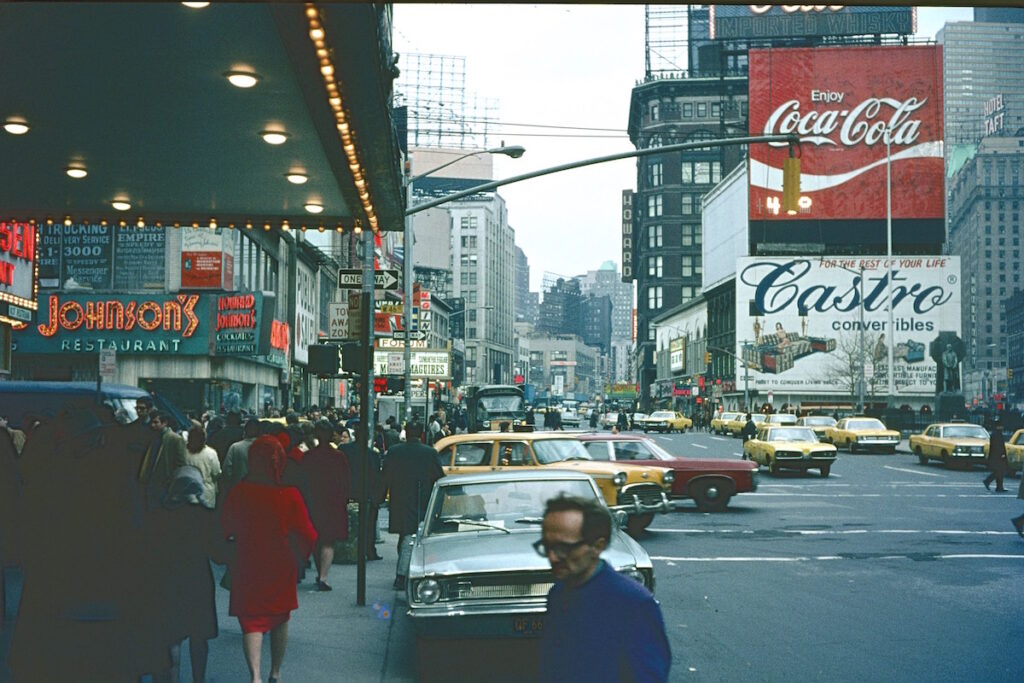In the heart of New York City, Times Square has often been called “The Crossroads of the World.” At the intersection of Broadway and Seventh Avenue, Times Square has been the place where people gather at momentous times in history–from the victories in Europe and Japan during World War II to every New Year’s Eve for well over 100 years.

These vintage Times Square photos uncover the rich history behind this uniquely American icon and capture its many evolutions throughout the years as cultural forces, the economy and technology have shaped its appearance.
Why is it called Times Square?
Times Square is named after the newspaper, The New York Times, which built its headquarters, the Times Tower, between Broadway and Seventh Avenue and 42nd and 43rd streets. A year before The Times moved into their building in 1905, New York City’s mayor signed a resolution that changed the intersection of 7th Avenue and Broadway from Long Acre Square to Times Square. And the rest, as they say, is history.
When completed, the new building, known as One Times Square, was the second tallest building in the city at the time. Nevertheless, the newspaper outgrew the building and moved to a new headquarters just eight years later. In 1913, they moved to 229 West 43rd Street which was home for the publication until 2007.

Times Square was originally called Long Acre Square–named after London’s horse carriage district because the area was used primarily as William Vanderbilt’s American Horse Exchange. Electric lights illuminating Broadway and an ever-growing number of cars in the city marked the end of Long Acre Square and brought Times Square into the 20th century.
When Did the Advertising Start In Times Square?
The first electrified ad appeared in Times Square in 1904 just three weeks after the opening of the Times Square subway stop on 42nd Street.

It didn’t take long for advertisers to start to compete for the biggest and most eye-catching ads in Times Square. One of the biggest was the chewing gum company, Wrigley. They erected a large electric sign in 1917 that was arguably the largest in the world at the time.

More attention-grabbing advertising innovation continued with the introduction of Camel cigarettes’ billboard that appeared to blow a smoke ring from a hole in the sign every 4 seconds. (it was actually steam and not smoke). The Camel billboard lasted from 1941 until 1966 from its mount fronting the Claridge Hotel.

When did the ball first drop in Times Square?
The first ball was dropped in Times Square on New Year’s Eve in 1907. The first ball had 100 25-watt light bulbs, was about 5 feet in diameter, weighed a hefty 700 pounds and was made of iron and wood. The first ball was lowered from a flagpole at the top of One Times Square by the sign company that built the ball, Artkraft Strauss. The company was responsible for the ball drop for nearly a century.

The ball has been lowered every year since then with the exception of two years during World War II (1942 and 1943) when New York City was under dimout conditions due to concern over possible enemy attack. At midnight on those years a moment of silence was observed.
In 1920 the first ball was retired and replaced with one the same diameter but made of iron and only weighing 400 pounds. That version lasted until 1955 when it was replaced by a lightweight 150 pound aluminium ball.

In 1981 the ball became the “Big Apple” and used red light bulbs and green ones for the stem. The ball was dramatically revamped in 1995 when 180 halogen bulbs, 144 strobe lights and 12,000 rhinestones were added along with a more precise, computerized system for dropping the ball. This ball was finally retired in 1999 in time for the new millennium.

The fourth ball for the year 2000 was constructed by Waterford Crystal. This version was 6 feet in diameter and weighed 1,070 pounds and included over 600 halogen bulbs, 504 triangle shaped crystal panels and 96 strobe lights.
For the 100th anniversary of the ball, the fifth ball went energy-efficient using LED lamps capable of producing over 16 million colors. But that ball lasted only one year making way for the ball you’ve seen since 2009 which is an impressive 12 feet in diameter, is weatherproof and contains 32,256 LED lamps.
Seedy Times Square of the 1970s and beyond
Times Square wasn’t always been a family-friendly tourist destination. From the 1960s, to the early Nineties, the area was known mostly for adult theaters, sex shops, prostitution and crime. Times Square in those days reflected New York City’s overall decline nearly declaring bankruptcy in the mid-1970s.


Times Square Goes Disney
Starting in the mid-90s Mayor Rudy Giulianai an effort to clean up Times Square to attract more upscale, tourist-friendly tenants to the area. “Undesirable” businesses were strongly encouraged to relocate and The Walt Disney Company bought and restored the historic New Amsterdam Theatre on 42nd Street. Disney’s presence on Broadway made family-friendly musicals like The Lion King a mainstay, drove out adult theaters and attracted other tenants like AMC Theaters, Planet Hollywood, an M&M store and other well known brands.

Times Square FAQs
Times Square is named after the newspaper, The New York Times, which built its headquarters, the Times Tower, between Broadway and Seventh Avenue and 42nd and 43rd streets.
The first ball was dropped in Times Square on New Year’s Eve in 1907. The first ball had 100 25-watt light bulbs, was about 5 feet in diameter, weighed a hefty 700 pounds and was made of iron and wood.
The first electrified ad appeared in Times Square in 1904 just three weeks after the opening of the Times Square subway stop on 42nd Street.
According to the New York City Police Department, an estimated 2 million people have packed into Times Square on New Years Eve in recent years.


